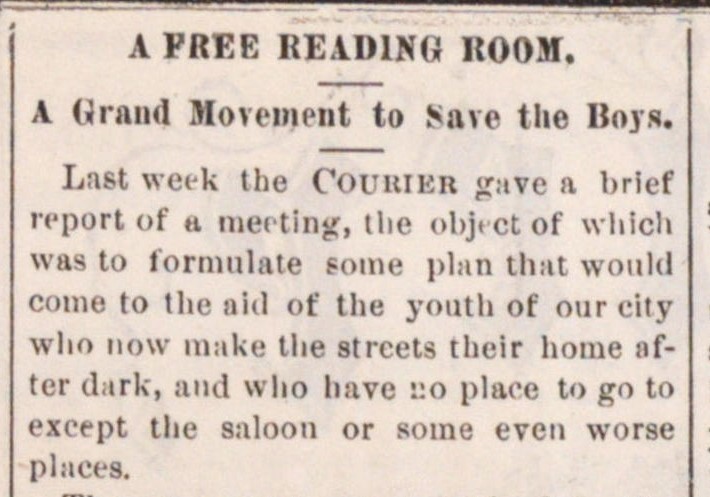By Karen Alvarez
Ann Arbor’s long history as a book town is filled with reading rooms and book nooks. This is a look at some of the earliest spots in the city, outside of schools and libraries. These reading rooms of the late 19th century were designed for different purposes, not always just for quiet study and contemplation.
In the 1870s, citizens wrote to the Argus newspaper in support of creating a city reading room with a club-like atmosphere. “Nearly every city in the state has one,” they contended, “why not Ann Arbor?” A space stocked with books, newspapers, magazines, a billiard table, playing cards, and board games would provide alternative entertainment to young men “who now make the streets their home after dark, and who have no place to go to except the saloon or some even worse places.” Unfortunately, due to a lack of funding and commitment, nothing came to fruition.
The issue was resurrected more than ten years later. A group of prominent citizens formed a committee to establish a “young people’s reading room” in 1886. Their plan was to rent space in the Gregory Block which stood at 100 N. Main. Reverend Samuel Earp of St. Andrew’s Episcopal Church was chosen to chair the committee. A local businessman named Willis Boughton agreed to lend his circulating library of 600 books and to assume daily management of the room. However, both Earp and Boughton moved out of Ann Arbor within a few years and no one stepped in to continue managing the room.

The distinctive stone Romanesque-style building at 100 N. State was built in 1882 as a Unitarian church with a reading room and library. Its catalog lists more than one thousand books and periodicals, many of them secular in nature. There were popular magazines like The Atlantic and Scribner’s, books on science, history, travel, poetry, and more.
The Ann Arbor Light Infantry club opened a reading room and other parlors in 1891, with great fanfare, on the second floor of the Hangsterfer Block at 200 S. Main. The club’s reading room was described as a spacious lounge, “complete in all its furnishing with large tables and easy chairs.” The building was demolished in 1925 and replaced by Kresge department store.

Wahr’s bookstore at 100 N. Main gained a reading room in 1891, furnished with a writing desk and newspapers from around the United States and Europe. Perhaps the most eclectically styled reading room was the one in Andrews & Company bookstore at 334 S. State (now part of Bivouac). Imagine stepping from the bustling street to, “drop in and rest in the easy chairs or sofa in the reading room, surrounded by flowers, canaries, Turkish rugs, new books, magazines, illustrated papers and enjoy the feast of reason and flow of soul.”


